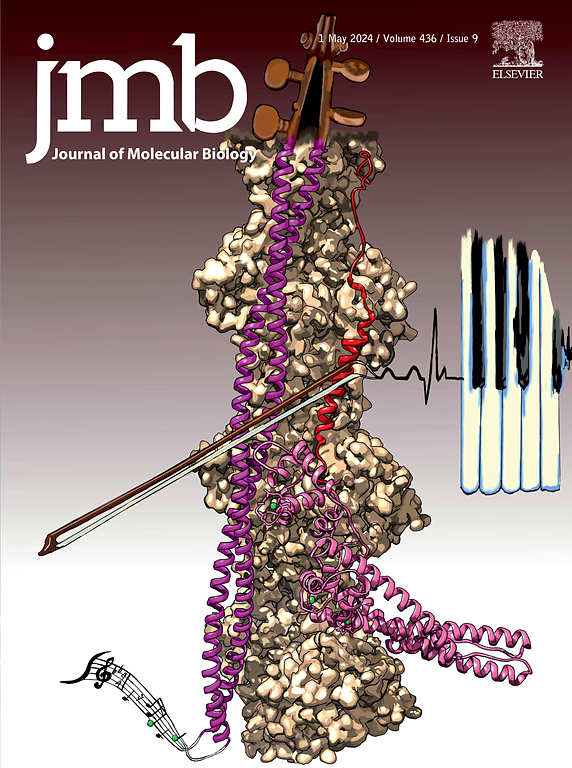Epitope structures recognised by antibodies against the major coat protein (g8p) of filamentous bacteriophage fd (Inoviridae) 1
IF 4.7
2区 生物学
Q1 BIOCHEMISTRY & MOLECULAR BIOLOGY
引用次数: 0
Abstract
To map the accessible surface of filamentous bacteriophage fd particles, the epitope structures of polyclonal rabbit serum and three mouse monoclonal antibodies raised against complete phage were analysed. Western blot analysis confirmed the major coat protein, gene VIII product (g8p or pVIII), to be the antigen. Overlapping peptides were synthesised by spot synthesis on cellulose membranes, covering the whole sequence of g8p. Each of the three tested monoclonal antibodies, B62-FE2, B62-GF3/G12 and B62-EA11, reacted with a core epitope covering ten amino acid residues at or near the amino terminus of g8p. The epitope recognised by B62-FE2 consists of the ten N-terminal amino acid residues of g8p. Extension of the amino terminus by various sequences did not inhibit binding, indicating that a terminal amino group is not essential for the interaction. Both B62-GF3/G12 and B62-EA11 recognise internal epitopes covering amino acid residues 3 to 12 of g8p. The epitopes of the polyclonal rabbit serum were also confined to the 12 N-terminal amino acid residues. The contribution of individual amino acid residues to the binding was analysed by a set of peptides containing individual amino acids exchanged by glycine. Accessible residues were Glu2, Asp4, Asp5, Pro6, Lys8, Phe11 and Asp12. The positions of the essential amino acid residues within the epitope are in accordance with a helical conformation of the amino-terminal region of g8p. Further, the results suggest new designs of phage display screening vectors to improve their performance in analysing non-linear epitopes.
丝状噬菌体fd (Inoviridae)主要外壳蛋白(g8p)抗体识别的表位结构。
为了绘制丝状噬菌体fd颗粒的可及表面,我们分析了兔多克隆血清和3种小鼠抗完整噬菌体单克隆抗体的表位结构。Western blot分析证实主要的外壳蛋白,基因VIII产物(g8p或pVIII)为抗原。在纤维素膜上点合成重叠肽,覆盖g8p的整个序列。三种测试的单克隆抗体B62-FE2、B62-GF3/G12和B62-EA11均与覆盖g8p氨基末端或附近十个氨基酸残基的核心表位反应。B62-FE2识别的表位由g8p的十个n端氨基酸残基组成。不同序列的氨基末端延伸不抑制结合,表明末端氨基对相互作用不是必需的。B62-GF3/G12和B62-EA11都识别覆盖g8p氨基酸残基3至12的内部表位。多克隆兔血清的表位也局限于12个n端氨基酸残基。通过一组由甘氨酸交换的含有单个氨基酸的肽来分析单个氨基酸残基对结合的贡献。可接近残基有Glu2、Asp4、Asp5、Pro6、Lys8、Phe11和Asp12。必需氨基酸残基在表位内的位置与g8p氨基末端区域的螺旋构象一致。此外,研究结果建议设计新的噬菌体展示筛选载体,以提高其分析非线性表位的性能。
本文章由计算机程序翻译,如有差异,请以英文原文为准。
求助全文
约1分钟内获得全文
求助全文
来源期刊

Journal of Molecular Biology
生物-生化与分子生物学
CiteScore
11.30
自引率
1.80%
发文量
412
审稿时长
28 days
期刊介绍:
Journal of Molecular Biology (JMB) provides high quality, comprehensive and broad coverage in all areas of molecular biology. The journal publishes original scientific research papers that provide mechanistic and functional insights and report a significant advance to the field. The journal encourages the submission of multidisciplinary studies that use complementary experimental and computational approaches to address challenging biological questions.
Research areas include but are not limited to: Biomolecular interactions, signaling networks, systems biology; Cell cycle, cell growth, cell differentiation; Cell death, autophagy; Cell signaling and regulation; Chemical biology; Computational biology, in combination with experimental studies; DNA replication, repair, and recombination; Development, regenerative biology, mechanistic and functional studies of stem cells; Epigenetics, chromatin structure and function; Gene expression; Membrane processes, cell surface proteins and cell-cell interactions; Methodological advances, both experimental and theoretical, including databases; Microbiology, virology, and interactions with the host or environment; Microbiota mechanistic and functional studies; Nuclear organization; Post-translational modifications, proteomics; Processing and function of biologically important macromolecules and complexes; Molecular basis of disease; RNA processing, structure and functions of non-coding RNAs, transcription; Sorting, spatiotemporal organization, trafficking; Structural biology; Synthetic biology; Translation, protein folding, chaperones, protein degradation and quality control.
 求助内容:
求助内容: 应助结果提醒方式:
应助结果提醒方式:


